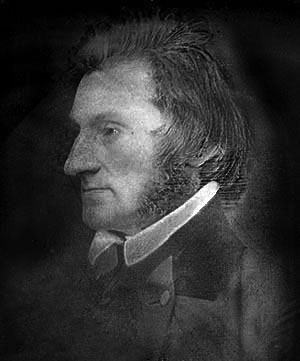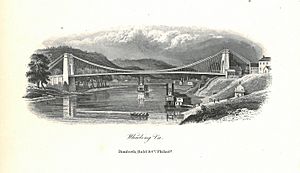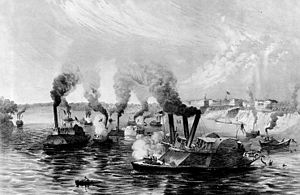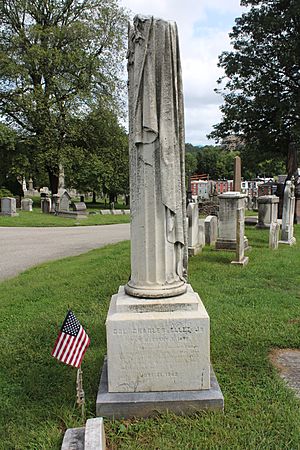Charles Ellet Jr. facts for kids
Quick facts for kids
Charles Ellet Jr.
|
|
|---|---|
 |
|
| Born | January 1, 1810 Bucks County, Pennsylvania, US |
| Died | June 21, 1862 (aged 52) Cairo, Illinois, US |
| Buried | |
| Allegiance | United States of America |
| Service/ |
Union Army |
| Years of service | 1862 |
| Rank | |
| Commands held | United States Ram Fleet |
| Battles/wars | American Civil War |
| Relations | Mary Virginia Ellet Cabell (daughter) Charles R. Ellet (son) Alfred W. Ellet (brother) John A. Ellet (nephew) |
Charles Ellet Jr. (born January 1, 1810 – died June 21, 1862) was a brilliant American engineer. He designed and built many important structures. These included canals, railroads, and amazing suspension bridges.
He built the Wheeling Suspension Bridge. For a short time, it was the longest suspension bridge in the world! He also surveyed the Mississippi River and Ohio River for the U.S. Army Corps of Engineers.
During the American Civil War, Ellet became a colonel. He created and led the United States Ram Fleet. This was a special group of ships designed to ram enemy vessels. His ram ships were key to a big Union victory at the First Battle of Memphis. Sadly, he was wounded in this battle and died soon after.
Contents
Early Life and Education

Charles Ellet Jr. was born in Bucks County, Pennsylvania. He was one of 14 children! He started working at a young age. He helped measure land for the Chesapeake and Ohio Canal.
In 1830, he went to Paris, France. There, he studied civil engineering at a famous school. This helped him become a top engineer.
Family and Connections
Charles Ellet Jr. married Elvira Augusta Stuart Daniel in 1837. They had several children. His brother, Alfred W. Ellet, and his son, Charles Rivers Ellet, also became important figures. Both served as officers in the Union Army during the Civil War.
His daughter, Mary Virginia Ellet Cabell, later helped start the Daughters of the American Revolution. This group honors people who fought in the American Revolutionary War.
Amazing Engineering Projects

After studying in Europe, Ellet returned to the U.S. He worked on railroads and designed bridges. In 1842, he built the first major wire-cable suspension bridge in the U.S. It crossed the Schuylkill River in Philadelphia.
In 1848, he built the record-breaking Wheeling Suspension Bridge over the Ohio River. This bridge had a span of over 1,000 feet! In the same year, he built the first suspension bridge over the mighty Niagara Gorge.
Ellet also worked on canals. He improved the Schuylkill Navigation Company canal. This canal was used to transport coal. He also developed ideas for controlling floods and improving river travel. He suggested building reservoirs (like big lakes) in the upper parts of rivers. These would hold water during rainy seasons. Then, the water could be released slowly to help with navigation and prevent floods.
In 1850, the government asked Ellet to study the Mississippi and Ohio Rivers. His detailed report helped shape future plans for flood control and river improvements.
The United States Ram Fleet

In 1854, Ellet learned about a ship accident. A smaller ship accidentally rammed and sank a much larger one. This made him realize that ramming could be a powerful naval tactic. He tried to convince the United States Navy to build ram ships, but they weren't interested at first.
When the American Civil War began, the Confederates converted a captured ship, the USS Merrimack, into a ram ship. It was renamed CSS Virginia. This ship sank two Union ships by ramming them! This showed the Union how effective ram ships could be.
In March 1862, Secretary of War Edwin M. Stanton finally listened to Ellet. Stanton knew Ellet's work on the Wheeling Suspension Bridge. He made Ellet a colonel and told him to create the United States Ram Fleet. This fleet would operate on the Mississippi River.
Ellet bought nine fast river steamboats. He converted them into ram ships. He even put his brother, Alfred W. Ellet, his nephew, John A. Ellet, and his son, Charles Rivers Ellet, in charge of some of the ships.

On June 6, Ellet led his ram fleet into the First Battle of Memphis. He was captain of the USS Queen of the West. His brother Alfred commanded the USS Monarch. The ram ships charged ahead of the Union gunboats.
The Queen of the West rammed and sank the Confederate flagship, the CSS Colonel Lovell. The Monarch then rammed and disabled another Confederate ship, the CSS General Price. Ellet's rams played a huge role in the Union's decisive victory.
During the battle, Ellet was wounded in the knee by a Confederate sharpshooter. He was the only Union casualty in the battle.
Death and Legacy

Sadly, Charles Ellet Jr.'s wound became infected. He died 15 days later, on June 21, 1862. His body was taken to Independence Hall in Philadelphia. He received a state funeral and was buried in Laurel Hill Cemetery. His brother, Alfred W. Ellet, took command of the ram fleet.
The U.S. Navy later named a destroyer, the USS Ellet (DD-398), in honor of the Ellet family. This ship served during World War II.
In 1999, a special plaque was placed on the Wheeling Suspension Bridge. It recognized Ellet's amazing work and his daughter's role in founding the Daughters of the American Revolution.

